Subtotal: $
Checkout
Learning to Love Grass
In the fight to save Britain’s meadows, ignorance of their importance is the greatest obstacle.
By Alex Rowson
September 1, 2023
There is something intoxicating about a British meadow in summer. The moment your feet plunge into the soft greens and browns of the grasses and the smell of ripening hay fills your nostrils, you know you are somewhere special. There is depth, variety, and texture in this profusion of life. Meadows are a world away from the sterile agricultural leys and permanent pastures that dominate the UK countryside. The wildflowers are undoubtedly the stars. They dot and thread the sward, their delicate tapestry unfolding dream-like before the visitor – oxeye daisy, common knapweed, betony, and the numerous sun-yellow members of the dandelion family. Sometimes orchids bloom among the host, each one a marvel. “The pure voice of the field,” as one poet called it, is ever-present. Skylarks, hidden in the vastness of the blue overhead, shower down their song, bees drone, grasshoppers and crickets chirp. Butterflies, like silent conductors, jink and twitch across the grass and the hidden orchestra below. A patch of silky fescues provides the perfect cushion to lie down and listen. To be in such places, even for a few minutes, is a natural joy, a celebration of country-life, a true summer spectacle.
And yet, for many of us, opportunities to see species-rich meadows (semi-natural grasslands that have not been ploughed, reseeded, or “improved” with fertilizer) are rare. This was not always the case. Meadows were still common up to the mid-1930s. Indeed, their abundance was closely linked with Britain’s self-identity – the green and pleasant land. Meadows are regularly featured in paint, poetry, and song. Through nursery rhymes such as “One Man Went to Mow” and the simple childhood pastimes of making a daisy chain or telling the time with blows on a dandelion clock, meadows stole into our imaginations at an early age and bedded down in our hearts. In addition to their cultural value, meadows were once highly valued resources, integral to the survival of pre-industrial farms. “Shut-up” in the spring to allow the grass to grow, they were cut in late summer – by which time the grasses and wildflowers had set seed, ensuring their propagation and survival. Haymaking was regarded as the peak of the year, a time associated with sweat and toil, community and parties. The resulting fodder kept the livestock going through winter. In the days before combustion engines, meadows provided the fuel that kept the countryside running.
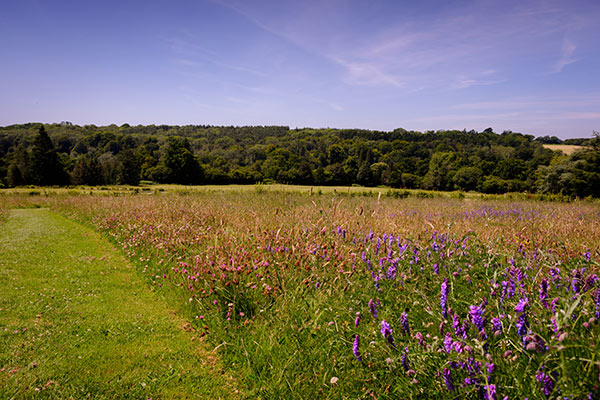
Coronation Meadow. Photograph by Jim Holden © RBG Kew. All photographs used by permission.
Things began to change with the outbreak of World War II. With disrupted trade routes and growing pressure on national food production, the government launched the “Dig for Victory” campaign. Hay meadows and pastures – along with commons, copses, marshes, heaths, hedgerows, and other so-called wastelands – were plowed up and planted with crops in the quest for self-sufficiency. Alongside rationing, the campaign was a success. But rather than being a temporary solution, the drive toward intensification continued in the postwar years. Government subsidies encouraged farmers to maximize their land’s agricultural potential. Improved machinery and a battery of artificial fertilizers, pesticides, and herbicides facilitated the increase in productivity. Silage and other alternative livestock feeds slowly removed the need for traditional hay meadows. This science-centered upscaling of agriculture delivered on its targets. Despite the United Kingdom’s rising population, food became ever more abundant and costs fell for the average consumer. By the mid-1980s, however, it became apparent what had been lost in the process: 97 percent of species-rich meadows had vanished. Widespread habitat destruction and chemical pollution had also caused an associated collapse in wildlife populations.
The government responded by introducing agri-environment schemes – the two main mechanisms being Countryside Stewardship and the creation of Environmentally Sensitive Areas (ESAs). The schemes sought to encourage farmers to set aside areas for wildlife and compensated them for any related loss of earnings. The initiatives managed to stem the tide of rapid destruction, but, overall, meadow habitats continue to shrink. For many farmers or landowners, the schemes do not provide enough money to make them worthwhile. The bureaucracy is tedious, and the one-size-fits-all management approach does not take local considerations into account. Meanwhile, there is no standard protection for ancient species-rich meadows. They are vulnerable to developers and, most of all, to agricultural change; decades’ worth of restoration can be plowed away in a matter of hours. As meadows are manmade and man-maintained habitats – requiring the right timing and amount of grazing, a yearly cut, and an organic approach to management – their preservation can be challenging, for both old and new landowners. They are also highly susceptible to neglect, quickly swamped by coarse grasses, weeds, scrub, and, eventually, woodland. But it is ignorance of their biological value that is arguably the real killer.
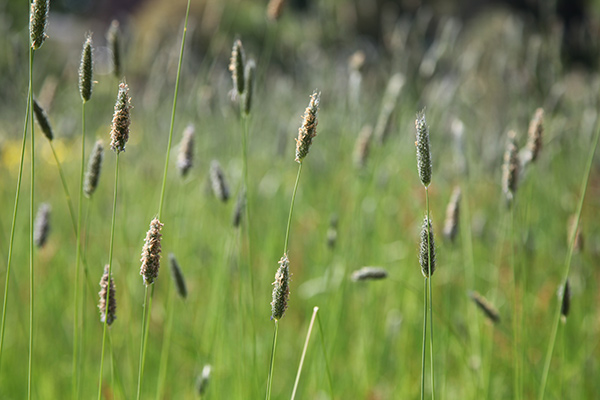
Meadow Foxtails. Photograph by Alex Rowson.
Since surviving meadows are generally small and isolated, they are not easily seen by the public. For much of the year they resemble any other green space. It is only in the spring and summer that they reveal their secrets, erupting into life. There is also confusion between annual arable meadows – known for the brash colors of poppy, corn flower, marigold, and cockle – and the more subtle perennial meadows, which are predominately grasses and perennial wildflowers. Things get more complicated when considering the varieties of these perennial meadows. They range from the marshy Culm grasslands of Devon to the sandy Machair of the Hebrides, from the water meadows of the Thames to the chalk downs of the South Country. Each is a unique product of geology, soil, and landscape and is capable of supporting a different floral community. If we have become ignorant of the wild plants around us, then we are undoubtedly also blasé about grass. Despite regularly tending to our lawns and visiting parks or playing fields, we typically give little thought as to the type of grass that makes these green spaces green, or its value to wildlife. Ryegrass, easily sown and grown, identified by its shiny, dark-green blades, has become the grass. Its ubiquity has drowned out our recognition of other native grasses. If species-rich meadows are to be conserved, we must begin by cultivating our own knowledge.
Learning to identify grass species not only gives us a deeper understanding of the natural world, but can also help us evaluate the health of a grassland and appreciate its value to biodiversity and wildlife.
The United Kingdom’s grass family is composed of some 110 native species, of which twenty-eight are considered core meadow species. Although harder to identify than wildflowers, they have a charm of their own, with many subtle differences and seasonal rhythms. Just as cuckoo calls and primroses announce the arrival of spring, so too does the flowering of sweet vernal grass. Its scent of freshly cut hay presages the harvest to come. In May, meadow foxtails are among the first to rise above the burgeoning sward, their small gray brushes swishing in the breeze. They are soon joined by feathery fescues and crested dog’s-tail with its beautiful braided seedheads. The approach of midsummer brings forth the playful flower heads of quaking grass, which bounce up and down on their stems like fish caught on a line, and the jutting lime-green cylinders of timothy. The field margins, meanwhile, begin to haze brown with common bent. Their tiny constellations of spikelets suspended on branches as fine as gossamer.
Learning to identify such species not only gives us pleasure in a deeper understanding of the natural world but can also help us evaluate the health of a grassland and, therefore, its value to biodiversity and wildlife. A predominance of aggressive or coarse grasses, such as Yorkshire-fog, cock’s-foot, tall fescue, or perennial ryegrass, accompanied by nettles, docks, and thistles, signal that the land has been “improved” with fertilizer. An abundance of nonaggressive grasses, on the other hand – common bent, sweet vernal grass, meadow foxtail, crested dog’s-tail, and the various fine-bladed fescues – provide the best matrix for wildflowers to flourish and are natural indicators of an unimproved grassland. In these environments, a typical quadrant of four square meters can reveal a diverse grass population, usually between eight to fourteen species, whereas in an improved pasture or ley you’d be lucky to find four.
Species-rich meadows are known to produce hay that is high in trace elements, which can improve livestock health, but their yields are low in comparison to sown leys. However, there is now a drive by conservationists, scientists, and charities to raise awareness of how meadows can benefit us and our environment in other ways, and the Weald in southeast England is at the forefront of the movement.
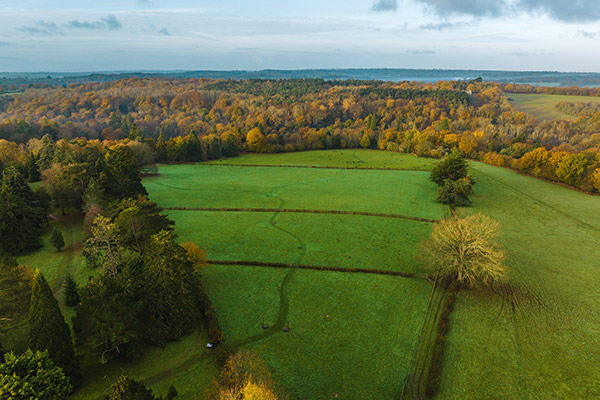
Coronation Meadow. Visual Air © RBG Kew.
Wakehurst Park, Kew’s wild botanic garden, just twenty miles north of Brighton, boasts over two hundred hectares of diverse landscape, with habitats and plants from across the globe. A walled garden and formal lawn sit side-by-side with an American prairie and Himalaya glade. Wakehurst’s Coronation Meadow, an initiative that aimed to publicize meadows and create new ones, was created in 2015 to celebrate the sixtieth anniversary of the Queen’s Coronation.
The entrance to the meadow is through a small gate set into a hedge. The views beyond are momentarily screened from view, but then, stepping through the portal, another world is unveiled. A string of meadows cascades downhill, dissolving into the woodland that pools at the valley floor. A simple mown path snakes through a tawny pelt of grasses and loose drifts of wildflowers. It feels timeless, as if this slice of pastoral beauty had always been here. But the truth is very different. “Creating the Coronation Meadow … has been a lesson in patience and perseverance,” says Iain Parkinson, Wakehurst’s living collections and conservation manager. “It simply takes time to create a flower-rich grassland and it’s important to hold your nerve and to allow time to run its course.” That patience has paid off and the meadow season here is one long procession of colors and forms while the “vertical and wiry-stemmed world of grasses,” as Parkinson describes it, provides the structure.
As well as helping to promote public interest, the meadow is also utilized for scientific experiments. In 2021, the meadow became part of Kew’s Nature Unlocked project – a landscape ecology program that has turned Wakehurst into a “living laboratory.” Last year, experts compared the benefits to pollinators of native plants in the meadow and non-native plants in Wakehurst Park’s American prairie. Meanwhile, in other areas of the estate, experts are investigating the role of plants in water filtration and flood prevention, which could help improve water quality and mitigate the effects of violent storms. However, one of the greatest benefits of grasslands is their ability to sequester carbon. Up to 30 percent of the Earth’s carbon is currently estimated to be stored in grasslands. The Wakehurst team has recently installed gas flux monitoring chambers in the Coronation Meadow which measure the release of carbon dioxide from the soil. As an example of a managed habitat, the data will help them build a picture of carbon storage across the estate, as well as further publicize the importance of grasslands in the fight against climate change.
In 2023, Kew published the book Meadow, a collection of thirty personal meadow stories curated by Iain Parkinson. Their primary aim is to illustrate and promote the importance of grasslands today. Farmers, artists, scientists, conservationists, land managers, and others share their thoughts, knowledge, and connections to Britain’s meadows. Enriched with a beautiful selection of photographs by Jim Holden, the book is truly inspirational. It showcases a meadow ecosystem of human activity as rich as any in the natural world.
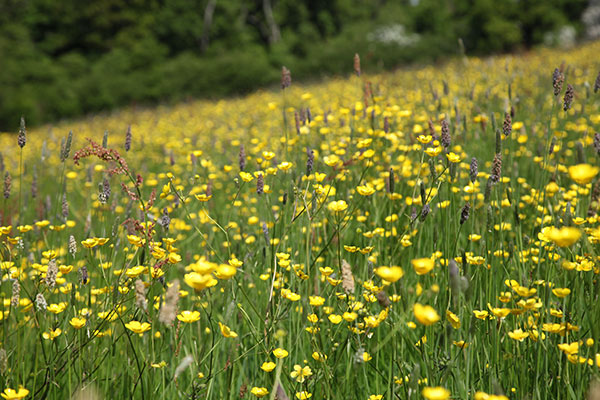
Buttercups. Photograph by Alex Rowson.
One of the contributors was Keith Datchler OBE, a retired farmer who has spent his life restoring meadows in the Weald. He now leads the Wild About Battle community group based in Battle, East Sussex. The group was formed six years ago with the aim to do more for local pollinators. It’s often said that if pollinators vanish then humans would quickly follow. The disappearance and fragmentation of meadows across the United Kingdom have significantly contributed to the decline in the population of flying insects over the past twenty years. Protecting and cultivating these habitats is at the core of the Wild About Battle project.
Datchler and his team began with the roundabout on which the 1066 memorial, a twisted metal statue depicting a Norman horseman tussling with a Saxon foot-soldier, stands today surrounded by gravel and palms. In collaboration with the city government, Datchler and his team decided to replace the gravel and palms with a meadow mix of grasses and wildflowers. Since then, Wild About Battle has expanded to cultivating these “Nectar Networks” in roadside verges and other green areas in and around Battle to sustain pollinators and provide safe habitats for a range of other invertebrates. “Just not mowing, allowing insects to complete their natural life cycles, can have a dramatic effect,” says Datchler. “And if we can get the bottom of the food pyramid right, the rest will follow.”
In this fight to preserve and restore biodiversity, grasses play a key role. They rank third in the list of the most important British plant families for insects and mites, supporting over eight hundred species – including the caterpillars of eight butterfly species. In summer, they provide shade and shelter for a wealth of wildlife, their seed is an important resource for birds, and during winter they are useful hibernacula for various insects. Unseen, in the soil beneath, undisturbed grasslands also support a dense network of fungi and communities of bacteria and microbes, an army of microorganisms many billions strong. They are a vital and underappreciated part of the life cycle, helping to break down matter and produce rich soil that can feed back into the plant world.
The Wild About Battle group are already seeing the benefits of not mowing their wildlife areas. In one wide verge on Caldbec Hill, for example, longhorn beetles and orange-tip, red admiral, and meadow brown butterflies, along with a host of spiders, hoverflies, and bumblebees, populate this mini-meadow. Moreover, these mini-meadows are beginning to link up with other habitats – woodlands, hedgerows, rivers, streams, ponds, and marshes – thereby creating the landscape-wide mosaic of habitats that wildlife needs.
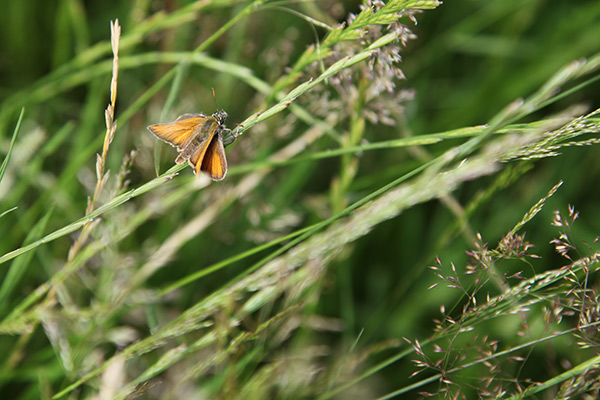
Skipper Butterfly. Photograph by Alex Rowson.
There are currently around two hundred thousand hectares of roadside verges throughout the country. None serve an agricultural purpose; most are mowed regularly purely for aesthetic reasons. A change in policy could be crucial in combating the extinction crisis, as well as saving councils money. Not everybody, however, sees the potential. Some Battle residents have complained about the untidiness of the wildlife areas. To them they are unsightly, a sign of neglect, a harbor of ticks and other “unsavory” creepy crawlies. This is symptomatic of our disconnect with nature, sadly many generations in the making. Seeing these wild spaces more regularly may help rebuild that connection. In turn, this can benefit our mental health, and Datchler has an intriguing theory as to why this is. “We are a grassland species,” he explains, “we came down out of the trees, stood up and walked to exploit the African Savannah.… We are designed to operate and function in grass. Wheat, barley, oats, rye, rice, and maize are all adapted grasses; without them we wouldn’t be where we are now. So, it’s no wonder that when you walk into a field that looks like it would have looked … that the hairs on your arms move. I think it’s a latent memory … a sign of well-being, that everything is OK.”
As we face up to the dire problems of climate change and tumbling biodiversity, it is now more important than ever that we awaken and listen to those primeval senses. Both for the good of wildlife, and our own well-being, we must learn to love grass again.
Already a subscriber? Sign in
Try 3 months of unlimited access. Start your FREE TRIAL today. Cancel anytime.







Sheila Twombly
What a fantastic article! I wish there was a way to print it directly from the article. I am having trouble e-mailing to all the people that I want to be aware of this research! Thank you so much. Sheila Twombly